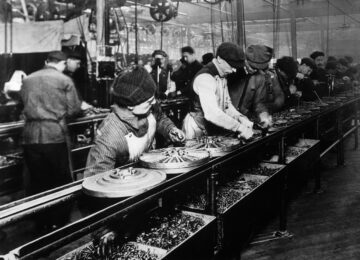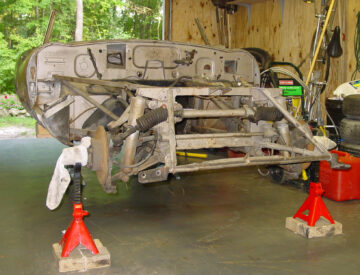by Mark R. DeLong

Rights: Public domain
Restoration of my old car took well more than a decade before it again powered itself along US Highway 501. With time and experience, differences between a craftsman and me would continue to diminish, as my inexperienced hands layered their actions into bodily remembered history and embodied knowledge. My hands remained bumbling and hesitant, though in time a little less than when I began. A craftsman’s hands would be effective and confident, mastering both tools and materials. The craftsman’s eyes, hands, and mind work in concert—far better tuned than mine. But despite the gulf of experience between craftsmanship and my labor, the years hunched over the car opened or, better, finely textured my understanding of how work helps to fulfill human life. That seemingly basic understanding was, paradoxically, obscured by the automobile itself.
A common element that the craftsman and I shared throughout the process amounted to the perspective of the whole project. Even when the car’s parts were contained in Ziplock bags, its chassis stripped to bare metal (much rusted through, too), my mind saw the product that my work, bumbling or not, could bring forth. Mine was an unjustifiably sturdy and very hopeful vision; the same would go for the craftsman, though he had skills to justify the hope. That hopeful perspective, justified and not, formed the strongest bond tying the craftsman and me.

In the mid-nineteenth century, William Morris used hope to draw the distinction between “useful work and useless toil.” “What is the nature of the hope which, when it is present in work, makes it worth doing?” Morris asked in Signs of Change (1888). “It is threefold, I think—hope of rest, hope of product, hope of pleasure in the work itself; and hope of these also in some abundance and of good quality.” Morris along with William Blake and John Ruskin nostalgically revered craft, and Morris particularly romanticized it. Yet, if nostalgia and idealism colored his vision of work somewhat, Morris understood the special qualities of craft work: its connectedness to meaning, its close tie to qualities of uniqueness, beauty, and durability—its reverence for things and the making of them.
Blake’s “dark Satanic Mills” loomed in the factories of the time. The three men yearned for the good old days of craftsmanship as a reaction to the indifferent brutality of the Industrial Revolution, though what they desired—a pleasantly medieval fantasy, really—may never have supplied the needs of their own time. Read more »
